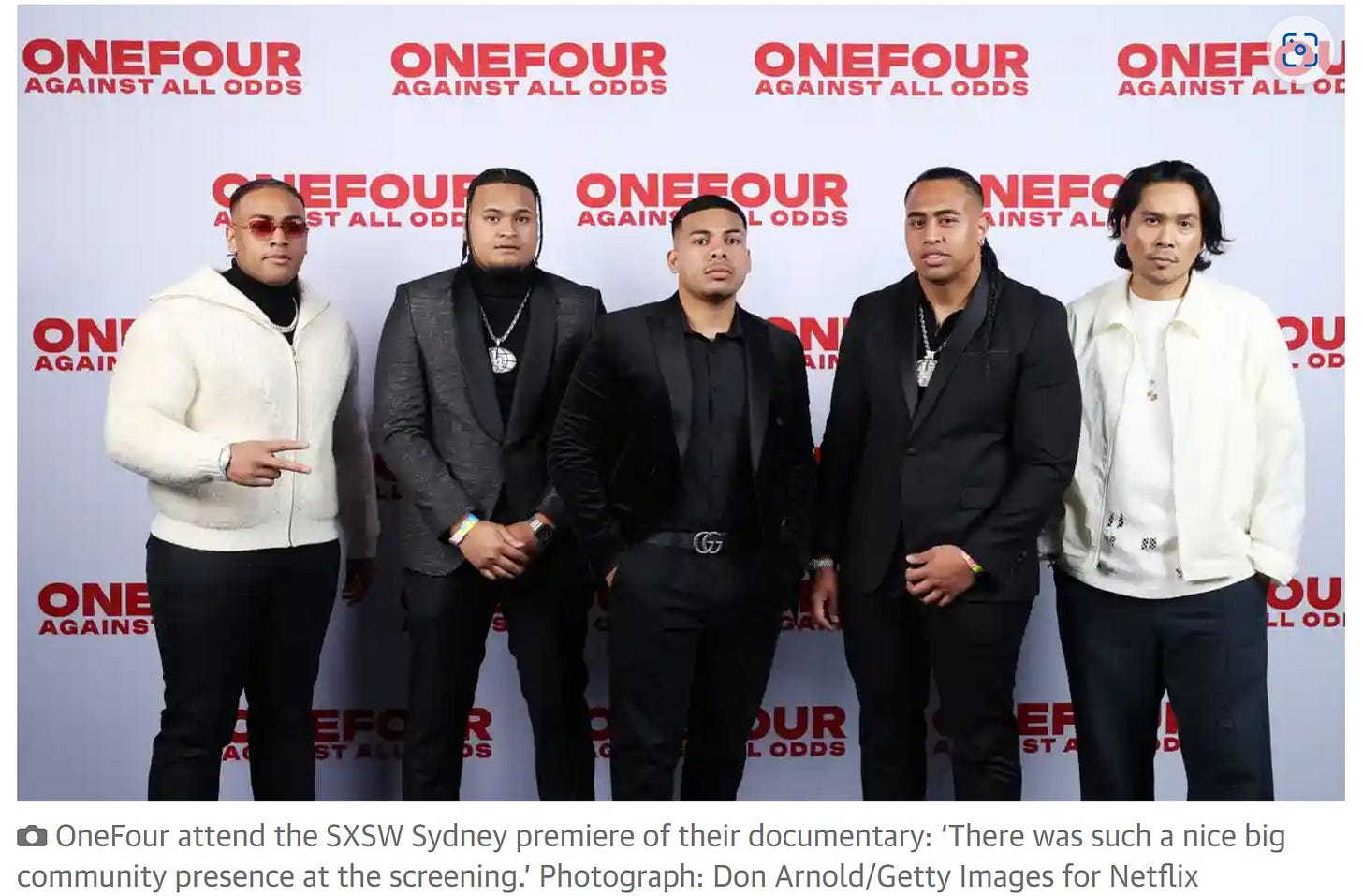Have you ever heard about OneFour?
The difference in how we respond to violent gangs and violent perpetrators of domestic violence (DV).
Yesterday afternoon I watched a new Netflix documentary with my son on the Australian drill rap band/gang, OneFour. The documentary called Against All Odds, follows the bands tumultuous path from one of the poorest areas in NSW, Mount Druitt, to tens of millions of YouTube views and the stage.
OneFour’s music is contentious, inflammatory; the lyrics come from the band member’s experience of growing up on the hard and tough streets of their hometown. And it is their lyrics that drew them to the attention of Strike Force Raptor – a NSW police squad who, by their own description, “target groups and individuals who engage in serious and organised crime”.
OneFour band members are not angels. Three members were jailed in December 2019 for their involvement in a viscous pub brawl where two men were stabbed, and another man was run over by a vehicle.
The pursuit of OneFour and its members by Strike Force Raptor was, and still is relentless. Australian State and Territory laws stop gang members wearing certain clothes, associating with certain people and allow for raids and the seizing of money and goods pretty much at will.
In the documentary a police sergeant can be heard saying to a OneFour band member “I’m going to use everything in my power to make your life miserable until you stop doing what you’re doing.” This included contacting any venue they were due to perform at, warning (or threatening depending on interpretation) them about the risk of losing their license if the performance went ahead. By doing this they essentially stopped the band from making money from legal activity (performing music).
So, NSW has a special task force to address the complex issue of gangs and organised crime. They are relentless. They will do anything and everything to make the life of the target of their attention as difficult as possible.
But has any state in Australia responded to the complex issue of DV with such a targeted, relentless approach towards the perpetrators of these crimes, to make their lives as difficult as possible? I think you know the answer. It is no.
To date, what we have seen is long reports detailing the extent of the issue (large), task forces to review the situation (much wringing of hands), strategies which do not measure outcomes on the improvement in women’s safety or reduced death rate and only a fraction of the budget required to address the issues.
So far in 2023, 58 women have been murdered (1). Three quarters of these murderers were known to their victim. In what can only be described as a violent murderous spree, six women have been killed in 10 days.
The recent cases involving (alleged) murderers Paul Thijssen and Cameron Pearson have attracted the media’s attention because of both the savageness of the attacks and the profile of the women they murdered. Both men attempted suicide after (allegedly) murdering the women. Thijssen died from his attempt, Pearson did not.
It is important to put this homicide-suicide DV activity into context. As Leslie Morgan Steiner, bestselling author and Washington Post alumni says “When abusive men threaten suicide, what they really mean is: I’m gonna kill you, and then if I have the guts, I might kill myself too. But definitely you.
We also know that based on the research conducted by the Western Australian Ombudsman and reported in "Family and Domestic Violence Suicide" (2), it can be extrapolated that 580 Australian women over the age of 20 who are known victims of DV will end their own lives each year. These are women who have reported DV to police, obtained a VRO or attended hospital with DV related injuries. There should be no question that DV related suicide is murder using the victims’ own hands as the weapon. These women are the unrecorded statistics in the DV related death toll.
Molly was one of these unrecorded statistics. In the weeks before her death her abuser sent her a message saying he would murder her and happily go to jail for the rest of his life. On the day of her death, he posted a photo on Facebook with his legs dangling over the edge of a very tall building. It looked like he was going to jump, the comments reflected this. Molly was packed ready to leave, however it is not hard to see how his continuous abuse, threat to kill her and threats to suicide made it near impossible for her to do so. She was rendered helpless and hopeless. In her mind, the only way for her to escape was to end her own life.
In total, if the murderous trajectory of women through both DV related homicide and suicide continues through 2023, around 630 Australian women who were alive on New Years Eve 2022 will be dead by New Years Eve 2023.
I’ll say it again for the people in the back row - six hundred and thirty women.
The violent crimes committed by the band members of OneFour deserved to be prosecuted, for sure.
But the disparity in Government, police, and community response between what is categorised as violent gang activity (a reasonably rare activity), to what is categorised as violent DV activity (a reasonably common activity) is outstanding.
This needs to change. Not tomorrow, now. Those who run programs for men who choose to use violence emphasise that men will only stop abusing and murdering women when they no longer benefit from their actions. Therefore, we urgently need a coordinated approach to correctly identify perpetrators, hold them accountable, and make their lives as difficult as possible until they stop what they are doing.





